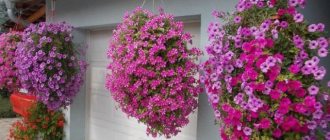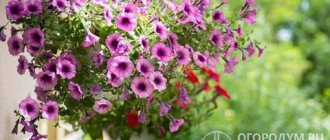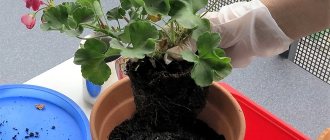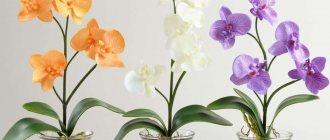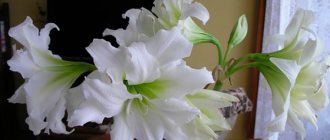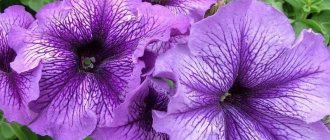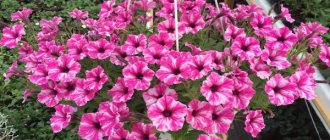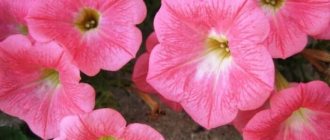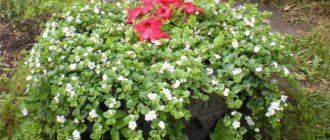Ampelous petunia is a popular and easy-to-care ornamental plant that is used to decorate garden plots and balconies. It has flowing shoots, densely strewn with small but bright flowers. Thanks to its shape and abundance of flowering, petunia looks aesthetically pleasing both in flower beds and in flowerpots.
There is a huge variety of varieties of this plant. They differ in the size and color of the inflorescences, the length of the shoots, and the foliage of the bush. Read on to find out which varieties of petunias are the most popular and what makes them special.
Types and varieties
Depending on the design wishes, the buyer can choose from seeds of bush, ampelous, low-growing, multi-flowered, double and fantasy varieties.
A special group consists of vegetative petunias. The peculiarity of plants of this type is that they can be propagated by cuttings. The world of petunias is represented by many species and varieties
Depending on the design wishes, the buyer can choose from seeds of bush, ampelous, low-growing, multi-flowered, double and fantasy varieties. A special group consists of vegetative petunias. The peculiarity of plants of this type is that they can be propagated by cuttings.
Possible problems
When growing small-flowered petunia, the following problems arise:
- Rain causes minor damage to the plant . If it is strong in summer, then drops of water tear apart the delicate petals, as a result of which the bush loses its decorative effect. With prolonged and prolonged rains, petunia stops blooming. If the plant is grown in a pot, then before the rain, bring it into the shelter. Watering should also be done carefully, at the root.
- Hanging varieties can be damaged by the wind , so place baskets and pots in places protected from the wind.
- In small-flowered double varieties, the appearance is spoiled by wilted flowers . They are especially noticeable in flowerpots and flowerpots. To avoid damaging the decorative appearance of the plantings, remove flowers in a timely manner.
In separate articles on our website you can familiarize yourself with other equally interesting and attractive varieties of petunias. We will tell you about such as Ramblin, Tidal, Typhoon Silver, Wave, F1 Gioconda, Starry Sky, Opera and Grandiflora.
Small-flowered petunia is an incredibly beautiful flower that decorates not only the flowerbed, but also apartments. An excellent option for novice gardeners who do not have specific experience in growing ornamental crops. If all agrotechnical conditions are met, the plant will bloom profusely and for a long time until frost.
The most popular varieties of ampelous petunias
Determining recognized favorites among ampelous petunias is not so easy due to their diversity. Listed below are the most common varieties of ampelous petunias, which have received recognition from gardeners around the world.
1) The group of varieties of hanging petunias “Easy Wave” is distinguished by its unpretentious character and variety of colors. Sometimes plants of this variety are classified as semi-ampeloid varieties because of the lush flower cap that crowns the vase or pot from which shoots strewn with flowers hang.
“Easy Wave” looks equally good in floor and hanging flower pots, and is sometimes grown in open flower beds and even in beds in the front garden. The shoots of this petunia variety can grow up to 1 m and during the flowering period are completely hidden under bright flowers. As for care, to successfully grow Easy Wave you will need quite spacious containers with a volume of at least 8 liters. In addition, these petunias are sensitive to lighting conditions, so if there is a lack of sunlight, it is necessary to take care of sources of artificial light.
Additional lighting will allow “Easy Wave” to bloom profusely throughout the season, until the first frost arrives. A related group of varieties, Shock Wave, is represented by luxurious double petunias, whose flowers look spectacular against the background of emerald foliage.
Plants of these varieties are most often grown indoors. Another close relative of Easy Wave and Shock Wave is the Wave Purple Classic variety. It is characterized by early and persistent flowering throughout the season. In mild autumn conditions, this variety can bloom until early October. Shoots of "Wave Purple Classic" quickly grow up to 1 m.
2) Among ampelous petunias, surfinias are very popular - plants with very powerful shoots that can grow up to 2 m, which brings them closer to cascading petunias. Thanks to this feature, surfinia petunias can withstand bad weather and successfully recover even after blows from storm winds.
The crown height of these plants can reach 70 cm. Thanks to their resistance to unfavorable conditions, surfinia will feel good not only in the sun, but also in a slightly shaded corner. Some gardeners grow them in garden beds and open flower beds.
The color range of surfinias is quite extensive and includes various shades of red, pink, white, purple and blue. “Table Yellow” is a relatively new variety of this group of petunias, which has already managed to win the sympathy of flower growers.
3) Another popular group of varieties of ampelous petunias is Avalanche. Their flower petals are typically red, orange, pink, white or blue.
4) Surfinia also includes another varietal group of ampelous petunias called “Velvet”. The flowers of this group are characterized by a velvety coating of the petals. Surfinia "Velvet" is very attractive to pollinating insects and is known for its honey-bearing qualities.
Among them, the Black Velvet petunia stands out for its unusual color - the diameter of its velvet flowers of a very dark shade can reach 8 cm. The height of the lush crown is 25-35 cm. The Purple Velvet variety boasts quite long for hanging petunias with shoots that can grow up to 1 m in a short period of time.
5) Hybrid varieties “Opera Supreme” belong to small-flowered ampelous petunias. The advantage of this variety is its unpretentiousness: it does not require additional lighting for abundant flowering. In indoor conditions, Opera Supreme can bloom almost all year round.
6) Ampelous petunias of the Explorer series varieties demonstrate a wide range of colors, impressive even for petunias. The strong and flexible shoots of these plants grow up to 1.5 m and safely withstand storm winds, and the waxy coating on the leaves makes them insensitive to rainwater.
7) The variety “Purple Waterfall” (Cascade Purple) is classified as semi-ampeloid petunias, which look equally impressive both in hanging and in floor planters, containers, and flower beds. "Purple Waterfall" is resistant to adverse weather conditions and heat. Another advantage of this variety of petunias is the early sowing and flowering period. You can start planting at the end of winter; it is enough to provide the seedlings with additional lighting.
Another large-flowered variety of ampelous petunias is called “Rapunzel”. Its shoots, growing up to 80 cm, during the flowering period are covered with flowers with a diameter of 8 cm. This variety tolerates drought and heat well, so it is optimal for gardeners who do not have the opportunity to regularly water their plants.
9) Early flowering is characteristic of the “Success Violet” variety. The height of the bushes of these petunias can reach 35 cm, and the length of the shoots ranges from 70 to 90 cm.
Small-flowered
Unlike bush petunias, this species has small flowers that impress few gardeners. However, what it lacks in flower size it makes up for in abundance. Bushes of small-flowered petunias are always strewn with a luxury of flowers.
The species is diverse, includes double and bicolor forms, is characterized by resistance to weather conditions, abundant and long flowering.
Small flowers of multi-flowered petunia cover the entire space allocated for cultivation with a dense carpet.
The developed varieties of this species have advantages over other plants:
- small flowers completely cover the petunia bush;
- early flowering periods;
- are resistant to cold and winds, do not wilt in rainy weather;
Modern F1 hybrids, bred by breeders, look decorative, and if planted in the front garden, then you simply cannot take your eyes off the flowering balls.
Charm (variegated mixture of colors)
Charm (variegated mixture of colors)
- An annual plant with a long flowering period. Many small flowers bloom on a compact bush up to 25 cm high;
- From a mixture of small-flowered petunia Charm you can create interesting compositions and decorate balcony boxes or plant them in a flower bed;
- Sowing seeds early - late February - helps to achieve early flowering. They are planted in a permanent location after the threat of return frosts has passed;
- It grows and develops well in fertile soil rich in nutrients. Does not like excessive watering, only when necessary. For lush and long-lasting flowering, it is recommended to apply mineral fertilizers;
- Flowering begins in July and continues until September.
Mirage
Variety Mirage with bright crimson flowers and white-green throat
- An annual plant with a bush height of up to 30 cm. The series includes petunias with flowers of various colors, reaching 6-8 cm in diameter;
- Compact bushes are completely covered with flowers throughout the growing season;
- The series is distinguished by the simultaneous formation of several rosettes. With proper care, flowering can continue until frost;
- Suitable for growing in open areas, as it is distinguished by its ability to quickly restore the decorative appearance of flowers after rain.
Classification of ampelous petunias
In the huge number of existing hybrid varieties and entire varietal groups, petunias are primarily distinguished by several parameters that characterize flowers:
| Parameter | Options |
| Flower shape |
|
| Flower sizes |
|
| Coloring of corolla and petals |
|
Ampelous petunia Easy Wave (Easy Wave)
This variety is one of the giants of the ampelous variety. Characteristics:
shoot length – 1 m;
long flowering until frost;
forms a dome-shaped or spherical crown;
flowers yellow, blue, red, purple, pink.
The variety is suitable for growing in hanging pots and open ground. All colors begin to bloom at the same time, so you can make compositions with numerous shades.
Ampelous petunia Velvet (Velvet)
A late-flowering variety of ampelous petunia, it attracts attention due to its abundant flowering and lush growth. Main characteristics:
shoot length – 1 m;
flower diameter 7 cm;
petals from pink to purple tones, velvety;
the tube is contrasting, yellow and black.
Petunia is an excellent honey plant. She attracts bees. There is high resistance to disease.
Ampelous petunia Opera Supreme (Opera Supreme)
The main features of this variety:
shoot length – 1 m;
flowers 6 cm in diameter, funnel-shaped;
color white, pink, lilac, light blue, dark blue.
The shoots branch well, so you can give them not only a hanging shape, but also a spherical one. Ampelous petunias are distinguished by long-term flowering, subject to the application of fertilizers and the removal of wilted shoots and flowers.
Large-flowered
Among the large-flowered petunias, “Waterfall Blue F1” stands out. The culture grows quickly and blooms early. Then flowering does not stop until frost begins. The variety can be used in hanging gardening. Even in very bad weather, the bush retains its basic qualities. Judging by reviews from flower growers, “Waterfall” performs best on borders, loggias and balconies.
The “Limbo” variety, along with the large-flowered variety, also belongs to the dwarf hybrid group. When growing such petunia in a room, its growth can reach 0.15 m. When cultivated in open ground - up to 0.2 m.
The same diameter (0.2 m) is typical for purple flowers. Interesting: “Limbo” can have multi-colored inflorescences on each bush. Of the more traditional varieties, Alderman deserves attention. This is an annual plant, stretching up to a maximum of 0.3 m. Shoots hang from a wide, dense bush.
An attractive feature of 'Alderman' is its large blue-purple flowers. They retain their attractiveness for 3 or 4 months. Group landing predominates. Caring for Alderman is relatively simple. Petunia can even be propagated by seeds.
Important: when growing seedlings you will have to put in a lot of effort. But, having successfully obtained adult plants of this variety, it is easy to decorate flower beds, balconies or simple grassy lawns. The “Prism” variety also does not require too complicated care in adulthood. This plant gives excellent results in all corners of the world - and is popular everywhere.
Important: despite the simplicity of the care rules, they cannot be ignored.
The slightest deviation can lead to bad consequences. Variety "Sofia F1" is a hybrid type that produces elegant flowers. The bushes branch strongly and bloom for a long time. They produce light pink flowers with juicy veins of carmine pink color. Bud diameter is 0.07-0.09 m.
The culture loves warmth and light and tolerates dry periods quite well. “Sofia” is planted both in groups and in large tracts. The plant is recommended for landscaping the balcony. By pinching the top early, you can increase the splendor of flowering.
“Floribunda” is not a variety, but a whole group that occupies transitional places from multi-flowered to large-flowered varieties of petunia.
The Sonya F1 series of hybrids falls into the same category. The height of the plants reaches 0.25 m. There are 11 hybrids, which can differ in the most unusual and expressive colors. The Celebrity F1 series is famous for its excellent resistance to heat and precipitation. In addition, representatives of the group are colored very interestingly, containing contrastingly colored veins.
Among the Celebrity petunias there are already over 30 different colors. Large-flowered plants can also be of the double type. This is typical for Madness hybrids. Some specimens develop white petals. The series is characterized by numerous flowers with a diameter of 0.07 m.
Multifloral
Of the multi-flowered group of petunias, Glafira is very popular. The variety forms a relatively modest bush. Its maximum height is 0.3 m. And in some cases only 0.2 m. But flowering begins in May (provided that the seeds are sown early).
“Glafira” is often used when you need to decorate a patio or covered terrace. However, it will look good on an ordinary window sill. The diameter of the flowers will be 0.045-0.065 m. Flowering does not stop throughout the season. Another positive feature is that “Glafira” survives short dry moments well.
The “Flame” variety is not named so in vain. When it blooms, it seems that the bush is covered with frozen fire tongues. The plant loves light and can tolerate short droughts. Flowering begins in June and ends only in September. The bush reaches 0.3 m and is quite dense.
Any nutritious soil is suitable for “Flame”. It is recommended to plant seedlings in May.
“Cherry Crystal” is an annual plant with a height of 0.3 m and a flower diameter of 0.07 m. When flowering, this mixture of petunias is covered with buds so densely that it is difficult to see the remaining parts. At the same time, extraordinary harmonious coloring is guaranteed.
The use of the Berenika variety also opens up excellent prospects. Petunia of this variety is characterized by relatively low growth. The annual is highly branched and creeping. It is often used for flowerbed planting, ridges, and large arrays of flowering plants. But you can use this petunia to decorate balconies and in the yard in a hanging basket.
Single flowers of "Berenice" resemble a funnel. Their diameter ranges from 0.05 to 0.07 m. Both stems and foliage are covered with a fluffy layer of hairs.
The Snow Globe variety achieves excellent performance only with the right choice of seeds.
If they take root well, then a fluffy and pleasant-looking bush will definitely appear.
Small-flowered
The Latin name for small-flowered petunias - milliflora - has long been included in gardening catalogs. All such plants are annuals whose stems grow straight. Height no more than 0.25 m. Small buds look like a funnel or a bell. The size of flowers ranges from 0.025 to 0.04 m.
“Pink F1” is distinguished by abundant branching. Plants develop flexible, powerfully developing side shoots. The flowers will delight people until the frost begins. They are made up of simple petals. “Yellow Duckling F1” is very close to “Pink” (both in the length of the shoots, and in growth, and in flowering).
The variety gives excellent decorative results:
- in open ground;
- in a flowerpot;
- in a hanging basket.
Plant Features
Petunia is a genus of perennial plants belonging to the nightshade family. In garden culture, flowers are grown as annuals . The leaves are soft, slightly pubescent, arranged in an alternate order. The buds are formed singly in each shoot axil.
The ampel group is characterized by thin long stems creeping along the soil or drooping in ampels - from 50-80 cm to 1.5-2 m. It also includes a separate category of so-called cascade (or semi-ampel) species. The main difference between them is that in cascade varieties the shoots are thicker and first grow upwards and to the sides before sagging under their own weight, while in ordinary hanging varieties they hang freely immediately.
Thanks to the flexibility of the lashes, this plant can be easily given any desired shape. It is suitable both for growing in hanging pots and baskets , that is, vertical gardening, and for cultivation in open ground in flower beds and flower beds as a ground cover .
When growing petunias as ground cover, long vines spread over a large horizontal area and turn it into a single variegated “carpet.”
Choosing a place for a plant
For petunias, it is necessary to select well-lit areas protected from the wind. The delicate petals of the plant cannot withstand gusts of wind and quickly wither. The flower will be comfortable in a flower bed located near the wall of the building. Petunia is often planted at the foot of large perennials; the plants do not interfere with each other, and protection from the wind will not hurt for petunia.
The flower has become widespread as a potted crop. The plant feels comfortable in the limited space of the pot. Flowerpots or pots with petunias are displayed on balconies, terraces, and they decorate the walls of buildings and window sills.
Petunia in a flowerpot
What time to plant
Loamy or sandy loamy fertile soil is suitable for growing petunias, and it will be very good if humus or compost is added to it before planting the plants. Fertilizing the soil with manure is not recommended because it can cause fungal diseases. For planting, you should choose a well-lit, open area. It is necessary to plant seedlings in the spring when there is no threat of return frosts (usually from mid to late May). Planting should be done in the evening or on a rainy day.
Fertilizer
Another important nuance of growing petunias is fertilizing. Intense flowering and growth of petunias require a constant supply of nutrients. This is one of the few ornamental plants that is in dire need of fertilizer.
Due to the special requirements for the amount of individual nutrients, including potassium and iron, it is better to use a special multi-component liquid fertilizer intended for petunias, surfinium. The fertilizer should be rich in potassium and iron, poor in nitrogen. It is worth recommending special fertilizers for petunias, which contain an additional dose of iron and help avoid the typical plant symptoms of deficiency of this element.
The dose and timing are established based on the information on the drug packaging, since excessive fertilizer can harm the plants more than help.
There is no such danger when using vermicompost - an organic fertilizer. However, although this is a very good preparation, it is not enough for plants that flower profusely. Regular fertilization begins 3-4 weeks after planting and continues throughout the growing season.
Buying petunias
The plant can be purchased already flowering or grown independently. In each case, a number of rules must be followed.
Seeds
When purchasing seeds, pay attention to the shelf life. The packaging must be intact and in good condition. It is desirable that it provides the most complete information about the varietal qualities of the plant and care features.
To be on the safe side, it is better to buy 2-3 packages of seed material of the variety you are interested in from several manufacturers and in different places.
Please note that the seeds can be in granules or dragees, that is, coated. This makes planting easier, since they themselves are very small, but the main thing is that, when dissolved, the shell supplies the plant with nutrients.
Petunia seeds are very small and collecting them from most varieties (hybrid ones labeled F1) simply does not make sense
Seedling
When choosing seedlings, pay attention to the appearance of the plants: they should be strong, without visible damage, mold, mucus or darkened areas.
Inspect the leaves to make sure there are no pests such as whiteflies, aphids or mites. If the flowers are sold in clear cups, inspect the roots. They should be well developed, without dry or rotten areas. When purchasing seedlings in a large cassette, make sure that there are no empty cells covered with leaves.
Strong, healthy seedlings take root faster after planting in a permanent place
Flowering plants
As with seedlings, check for external signs of the plant's condition. Make sure that the lower parts of the shoots have not begun to become bare.
The lashes should not be too long, otherwise the flower may be damaged during transportation.
Plants purchased in compact pots must be immediately transplanted into containers of suitable volume (5-10 l)
Care
Petunia needs careful care, only then will it show itself in all its glory. The soil in the flower garden is kept free of weeds and is regularly loosened shallowly.
Water petunia only with water heated in the sun, strictly at the root, twice a week. In hot weather, flowering plants require daily evening watering.
Flower feeding is applied twice a month in the form of liquid solutions. Immediately after planting the seedlings, the main element in the fertilizer is nitrogen. It is responsible for the active growth of green mass.
During the period of budding and flowering, petunias are fed with a predominance of phosphorus and potassium. It is convenient to use ready-made complexes for petunias or universal flower fertilizers (Pokon, Kemira Lux, Raduga, Fertika).
To preserve the decorative appearance of petunia bushes, faded buds are removed from the plant. Ampelous and cascading forms of plants can be formed by cutting, giving them the desired shape.
Growing conditions
Caring for ampelous petunia is based on standard agricultural technology and implies the following rules:
- lighting at least 12 hours a day, otherwise the plant will form few buds;
- daily watering, on hot days in the morning and evening;
- fertilizing with mineral fertilizers (for flowering plants every 5-7 days);
- pinching shoots at the stage of formation and when the lower part is exposed (2/3 of the length);
- constant removal of fading flowers so that the plant does not waste energy on ripening seeds.
When grown in a perennial crop, in order to preserve petunia until spring, in the fall its shoots are cut off radically, leaving about 10 cm from the ground, after which the pot is placed in a bright room with a temperature of +7...10 ℃. The plant needs to be watered approximately once a week. In the spring, you need to do formative pruning, and then transfer the flower to a larger container with enriched soil.
At home, it is quite difficult to ensure a safe winter for petunias, so many people prefer to acquire new plants at the beginning of the season.
Mr. Summer Resident advises: how to preserve a petunia bush in winter
It is not recommended to leave garden crops in the ground during the cold season. The plant is removed from the soil in mid-October. The next step is to eliminate all shoots. The pot with the transplanted petunia is placed in a cool room. Watering should be rare and moderate. Overwatering will cause rotting of the root system. In February, the container should be brought into a warm room. The resulting cuttings can subsequently be used for propagation.
Today, these hybrids are planted as balcony and potted crops. Bright annuals are often grown in garden plots. The popularity of petunia is due to its decorativeness and unpretentiousness. Additional benefits include a long flowering period. Petunia harmonizes well with other garden crops.
Vegetative petunias
Modern series of petunias. The plants do not set seeds and propagate only by cuttings.
Petunias come to our country from different countries, for example, Dutch and American petunias have proven themselves well. All varieties have a weakly branched root system.
All varieties quickly grow green mass and bloom profusely. If you look at a blooming vegetative petunia, a huge ball strewn with bright flowers appears before your eyes.
Cardinal
Cardinal
- The most common and beautiful variety of vegetative petunia;
- The color of the flowers is deep purple. The edges of the petals are slightly corrugated;
- The variety blooms very early;
- With good care, flowering can continue until the first frost. Unpretentious and resistant to changes in weather conditions;
- The rich shades of the Cardinal variety are majestic. Looks beautiful in a hanging pot.
Diseases and pests
In our climate, petunias will not survive the winter, so protection for the fall is not needed - faded, drying plants can be thrown away. Unfortunately, the short life of a petunia comes with many other problems.
Petunias are not completely resistant to diseases and pests. They are struck by:
- aphids - insects that damage plants and transmit viruses;
- viruses;
- fungal diseases.
The most common viral diseases affecting petunia are:
- cucumber mosaic virus;
- tobacco mosaic virus;
- potato mosaic.
Unfortunately, nothing can be done with diseased samples - they must be quickly destroyed.
Cultivation errors contribute to the emergence of diseases and pests. In the case of pests, soil-based insecticides are used for control. Before fungal diseases appear, it is better to carry out prevention, because spraying is not very effective with a large mass of flowers and leaves. Infected plants can be treated with specialized drugs.
A common disease is the so-called white mold - a white coating on petunia leaves. The flower dies literally before our eyes. Spraying is carried out 2 times per season.
It is important to carry out the following preventive measures:
- remove fading inflorescences;
- put antifungal sticks in pots
- pour out excess water from the stands;
- apply appropriate fertilizer;
- avoid irrigating plant leaves during watering;
- ensure that there are no other diseased plants in the immediate vicinity of the petunia;
- arrangement of flowers under the roof - rainy weather can provoke the development of fungi and physically destroy flowers and leaves;
- It is advisable to plant petunias in white boxes - dark ones attract heat, the roots overheat.
Tall and low-growing varieties (photo)
Tall varieties
They are usually placed in tall flowerpots so that the full splendor of the bush can be appreciated. Here are a few varieties that experienced gardeners recommend.
- Typhoon Cherry F1. This hybrid can be considered gigantic, as the length of the shoots reaches 1.5 meters! The flowers are small - only 5-6 cm. The root system is powerful, so it is recommended to plant this variety in flowerpots with a volume of at least 30 liters.
- Tidal wave parple. The length of the stems is slightly less than that of the Typhoon - about 90-110 cm, but with very good care they can grow up to 150 cm. The height of the bush is no more than 60 cm, the flowers are small - 5-7 cm. The hybrid is very popular among landscape designers and It is often used in compositions. Another difference of the variety is its good adaptability to different weather conditions.
- Opera Supreme Pink Morn. The length of the stems reaches 120 cm, while the bush grows in height by only 10-20 cm. It is recommended to plant in large flowerpots with a volume of at least 15 liters.
Low growing varieties
- Pirouette purple F1. The bushes are low - about 25 cm tall, and branch well. The flowers are densely double, with purple petals bordered by a white jagged stripe. Flowering period from May to October.
- Hula Hup. An elegant large-flowered variety with an abundance of shades and super early flowering. Compared to other large-flowered hybrids, this one blooms 12 days earlier. A bush with a large number of flowers, each 7.5-8 cm in size. The color is purple-blue with a white rim around the edge.
- Lambada. A small and compact plant up to 25 cm high. Blooms profusely from the beginning of May until the onset of frost. The flowers are small, 5-7 cm.
Petunia Lambada Burgundy
Reproduction
Petunia is most often propagated by seeds. You can collect them from your flowers yourself (they have time to ripen in the middle zone) or buy them in a store.
Petunia seeds are very small, sometimes seed producers process them. Dried seeds are easier to sow; their coating of fertilizer allows the plant to receive nutrition as soon as the sprout appears.
To enjoy flowering longer, petunia is sown early - at the end of January or February. The soil is prepared from a mixture of peat, sand, and turf humus. Petunia can be sown in boxes or directly in separate pots, peat tablets.
Important! The seeds are laid out on the surface of the soil without covering them with soil!
Some gardeners practice sowing petunias in snow, sowing seeds on a layer of snow laid on seedling soil. This method helps to distribute the seeds evenly (dark seeds are clearly visible on white snow). The snow, gradually melting, feeds the seeds with useful melt water.
Seeds
Before germination, the crops are kept covered with film or glass in a warm place. After the emergence of seedlings, the shelter is removed gradually, accustoming the seedlings to fresh air.
Caring for seedlings consists of watering, loosening and picking in the phase of 4 - 5 true leaves. Until the beginning of April, planting petunias must be supplemented with light, extending the daylight hours to 11 hours. During the growing of seedlings, they are fed twice:
- a week after germination with nitrogen fertilizer;
- after picking - potassium.
Petunia is planted in the ground only when the weather is warm. Lowering the temperature to 0 degrees can destroy a delicate plant.
The distance between petunia bushes is maintained at least 30 cm for compact forms, and at least 60 cm for large ones. There is a vegetative way to propagate petunia - cuttings. It is used for varieties that do not retain their qualities when propagated by seed.
Seedling
The mother plant is placed in a spacious pot in the fall and stored in a bright and cool (temperature +14 +18 degrees) room. Petunia is not fed and watered not often.
By March, the bush is brought into a warm place, watering is increased, and nitrogen fertilizing is applied. When stepsons actively grow on a plant, they are cut off and rooted. The cuttings are dusted with Kornevin or Heteroauxin, and the branches are placed in damp sand or vermiculite. The top of the container with cuttings is covered with a greenhouse.
The cuttings are regularly ventilated or the soil is watered moderately. After 2 - 3 weeks, a good root beard will form on the seedlings. Seedlings from cuttings are planted in a flowerbed in the same way as plants obtained from seeds.
Petunia propagation by cuttings
Propagation by cuttings is suitable only for double and ampelous petunias, as well as for all cultivar groups of mini-petunias (calibrachoa). Terry varieties can be propagated by cuttings in the last weeks of winter, the first weeks in spring, while mini-petunias and ampelous ones can be propagated all year round, but for this they will need additional illumination with fluorescent lamps, as well as warmth (from 21 to 24 degrees).
Cut the apical cuttings, which should have 4 to 6 leaf blades. Tear off all the leaves except the top two. The remaining leaves should be shortened by ½ part. The cuttings need to be planted for rooting in the same soil mixture that is used for seedlings. However, in this case, the surface of the substrate should be covered with a layer of perlite or sand 20–25 mm thick, which must be spilled with a fungicide solution. A distance of 15–20 mm must be maintained between the cuttings, and the container is covered with glass on top.
It is unnecessary to use growth stimulating agents (for example, Heteroauxin), because freshly cut cuttings take root well, but you should not delay planting them. The substrate in the greenhouse should be slightly damp at all times; for this, the petunia needs to be moistened twice a day with a spray bottle. However, it should be noted that excessive dampness contributes to the development of “blackleg” or mold. Terry and ampelous petunia will take root completely after approximately 7 days, and mini-petunia after 14 days.
After the roots reach 10–15 mm in length, the plants must be planted in individual pots, the diameter of which should be 50 mm. In order for the plants to bush more strongly, they must be pinched above the 4 or 5 leaf plate. The tops of the stems remaining after pinching can be used as cuttings.
After half a month, if necessary, the stems are pinched again. After 6 weeks, such plants are transplanted into pots whose diameter reaches 11–13 centimeters. You need to care for growing cuttings in almost the same way as seedlings. However, it must be taken into account that ampelous petunia and mini-petunia require a lot of free space, and therefore it is recommended to hang the containers with them.
Collecting seeds
Seeds should be collected only after they have fully ripened on the bush. During the flowering period, you should mark the bushes of those varieties from which you will need to collect seeds. It should be noted that the lower buds are used to collect seeds, because in them the seeds form and ripen faster. After the bud is fully formed, you should wait 8 weeks; after this time, the seeds in them will fully ripen. The seeds of such a plant are small (diameter approximately half a millimeter), there are approximately 100 of them in one box.
Shake the ripened seeds out of the boxes and distribute them into bags, do not forget to label the year of collection, variety and color of the flower. You can also simply cut the boxes and place them in storage at home. The seeds need to be ripened; to do this, they are stored at room temperature for 3–4 months. If the seeds are stored correctly, they remain viable for up to four years.
Petunia cascade
The cascade subspecies has four features that distinguish it from others, including hanging varieties:
- The shoots are thicker. They are well-fed and durable, and do not break from gusts of wind.
- The growth of green mass occurs due to aerial shoots. They point up, but then begin to droop down.
- If Petunia Cascade was planted in a flower pot, it looks like a huge ball with loops.
- The cascade subspecies also has rather large buds, reaching 5 cm.
Petunia
Landing Features
As a rule, the plant is grown from seeds. Planting and care begin as early as February, although sowing can be carried out until April. The mixture is bought in a store or prepared independently from peat, sand, humus, and turf soil in equal quantities. Expanded clay is used as drainage.
- Distribute the seeds evenly.
- Lightly sprinkle with soil, crushing it in a sieve.
- Spray with water from a spray bottle and cover with glass.
- Place in a well-lit room with a temperature of 18 to 24 degrees.
Lilac petunia flowers
The first 2 weeks of supercascade red petunia and other varieties are watered daily. A couple of crystals of potassium permanganate are thrown into the water for irrigation to prevent diseases and accelerate growth. The emerging sprouts are gradually hardened and taken outside. When representatives of the Solanaceae family grow up, they are planted in containers with peat. Then they add fertilizer.
Popular varieties
For several years now, these plant varieties have been particularly popular among flower growers. What varieties are we talking about?
- Gioconda. The bush is small, but there are many branches. Medium size flowers. Well adapted to temperature changes.
- Ramblin'. It grows up to 40 cm, but the shoots stretch another meter. Refers to early varieties.
Petunia red
There is also a giant cascade petunia or Supercascade. We are talking about a variety series of large-flowered plants that form entire cascades of flowers up to 12 cm in diameter. Blooms early and abundantly. In our country, supercascade white, supercascade pink, and giant petunia are often planted in balcony boxes and hanging baskets.
After flowering
If you want to save the flower, you need to remove it from the ground in October, and remove all the branches from the bush. The shrub is moved to a container in a cool place. It will need to be watered occasionally to keep the soil moist enough. When the month of February arrives, the plant is moved to a windowsill that is well lit by the sun. It must be warm there.
Petunia grandiflora
Now you will need to water it more often. When 2-4 pairs of leaves are formed, the plant is cut off at the “heel” and moved to a flowerpot. They must be filled with soil with nutritional properties, and a layer of sand placed on top of it.
The container is also covered with film or glass is placed and moved to a place where there is moderate shade. For 20 days you will need to water, ventilate and spray the sprout. By this time the shoots should have taken root. Afterwards I transplant them into cups. They are transferred to open ground at the same time as the seedlings are transplanted.
In the fall, faded bushes that are no longer needed should be removed from the ground and burned. After this, the soil must be dug up.
Growing from seeds
To get early flowering of petunias, you will need to sow seeds for seedlings in February-March. The development cycle of petunias has a long period; the plant blooms only 10 weeks after sowing. Seedlings are grown at home.
A mixture of varieties of double and semi-double petunia
In order for the seedlings to turn out healthy and strong, a number of conditions will need to be met, because petunia is a harmless plant only at first glance. But practice shows that it requires proper care, only in this case it pleases the owner with abundant flowering.
Seed selection
Creating beautiful compositions from petunias begins with the correct selection of seeds.
- To decorate hanging flower pots or boxes, you need to choose hanging varieties. It is important to know that even with regular pinching, petunia seedlings still grow poorly, so when transplanting seedlings into containers, the seedlings will have to be planted closer together;
- Bush varieties are suitable for decorating flower beds and ridges;
- Which seeds are better: coated or regular? There are fewer problems with ordinary seeds, and caring for them is familiar. But you’ll have to tinker with the sugar-coated ones. The fact is that they germinate only in moist soil; if you allow the earthen clod to dry out even slightly, the seeds will dry out. That is, when sowing pelleted seeds, it is necessary to constantly monitor the soil moisture;
- A mixture of varieties is much cheaper, but expectations and reality do not always justify each other: you can get plants of the same color and then you won’t have to talk about creating any composition. It is better to choose petunia according to specific varieties.
Dried and shelled seeds. As practice has shown, pelleted seeds are the key to successful growing of plants, but subject to maintaining air and soil humidity
Many gardeners complain about poor seed germination. When purchasing, it is important to pay attention not only to the production date and expiration date, but also to the manufacturer.
What determines the timing of sowing seeds for seedlings?
In magazines for gardeners, many recommend timing the sowing of seeds by the end of March. This time is characterized by a good length of daylight, which will allow the seedlings to form a good rosette and not reach for the light. If you sow earlier, you will have to add additional light to the plants.
Variety of varietal petunias: photos of flowers
Let's consider the rules for sowing seeds depending on room conditions:
- If the windows face south, the seeds are best seeded in the first ten days of March.
- If it is possible to organize artificial lighting, you can sow seedlings at the beginning of February.
- Windows on the north side receive little light, so sowing seeds should not be done earlier than the end of March.
If planted early without the possibility of additional lighting, the seedlings will develop poorly: growth will slow down, the seedlings will look frail and unable to resist diseases.
If planted late, the flowering period will be slightly delayed. You can't sow seeds too early or too late.
You need to know that flowering occurs 3.5-4 months after sowing the seeds.
Soil selection
To successfully grow seedlings, it is necessary to select high-quality soil containing all useful substances. It is important that the soil does not cake over time, otherwise a fungal environment will form on the surface and the plants will die.
Specialized stores sell soils intended for sowing seeds and growing seedlings. Undoubtedly, there are advantages to such soil, however, you need to look at the composition of the soil.
If a large amount of high-moor peat is included, it is better to discard such soil, since after 2 weeks from the start of its use, the soil sours and mold appears on the surface.
This is not because improper care was carried out, it’s just that the soil was not originally intended for use in its pure form. It is better to use it as an additive to ordinary soil, and then only in small quantities.
This is the best soil for planting flower crops
However, I would like to draw your attention to the fact that it is better not to buy huge bags of 25 liters, but rather 10 liters. The fact is that a smaller volume is sold out faster and the soil does not stay in stores for a long time.
High-moor peat has an acidic environment and therefore reduces soil acidity. You can reduce acidity using dolomite flour or lime, but young petunia seedlings will not like this.
When choosing soil, it is important to pay attention to its composition.
If it is written on the package that it contains high-moor peat, it is better to refuse the purchase, otherwise all your efforts in growing petunia seedlings will fail.
TerraVita soil has proven itself well. It does not cake; the production is based on coconut fiber, which ensures good breathability. In such soil, the seeds not only germinate quickly, the seedlings quickly gain strength and begin to grow faster, which is an important condition when growing petunia seedlings.
Priming
To prepare the soil at home, you will need to take turf soil, peat and sand. When choosing sand, preference should be given to river sand, but not to street sand. In ordinary sand, the content of iron oxide is off the charts.
The color of river sand is grayish or white.
Before preparing the mixture, each of the components must be sifted to remove lumps and small stones
After this, combine turf soil, peat and sand in a ratio of 2:2:1. To disinfect the soil, you will need to calcine it in the oven, remove it and leave it for 2 days to enrich the soil with natural microflora. Only after this will it be possible to sow petunia seeds.
Selection of containers and sowing seeds
For sowing, use seedling containers, peat cups or peat tablets.
What do experienced flower growers advise?
All containers are good, however, according to reviews from flower growers, it is not recommended to use peat cups, since the soil in them dries out quickly, and petunia develops very poorly.
Petunia seeds germinate in the light, so when sowing granules you should not bury them in the soil, you can only press them lightly.
If the temperature is maintained, the seeds hatch very quickly. The optimal air temperature is +25 ° C. Air humidity is important, which should be at least 98%.
Petunia seedlings
Of course, the conditions are simple, but they must be met. To maintain humidity, you can cover the plantings with plastic wrap and place the cups on the windowsill. It's good if there are batteries under it.
In order for the seedlings to breathe, the mini-greenhouse will have to be ventilated from time to time. The film can be replaced with non-woven fabric. After the seedlings grow a little, they are accustomed to room temperature, only removing the cover for a couple of hours a day.
Peat tablets are a good option for growing seedlings, but they are only good if you sow seeds only for yourself, since the tablets are not that cheap, considering that only one petunia rosette is grown in one tablet.
Before sowing the seeds, dip the tablet in water, wait until it gets wet, remove it from the water and place one seed at a time. Soak the tablets for 10 minutes. Many are afraid that it will swell too much. No, the tablets absorb as much moisture as necessary.
Before use, peat tablets will have to be saturated with water so that they increase in size.
When grown in tablets, seedlings do not have to be planted; they will develop in them until they are transplanted into the ground.
After sowing the seeds, the tablets are placed in a container with a lid to create greenhouse conditions. Further care is the same as for seedlings in cups. It is important to monitor the seedlings and prevent condensation from accumulating on the lid.
To remove excess moisture, you will need to remove the lid and ventilate the plantings. In the first weeks of life, seedlings are very capricious. At this time, the root mass is growing and there is practically no development of green mass.
Seedlings begin to grow 1.5 months after emergence.
Picking seedlings into separate cups
When the seedlings grow up, they are transplanted into separate containers: plastic disposable cups, small pots with good drainage holes, jars of yogurt or sour cream (budget option).
When choosing the size of containers, you should take into account that petunias have a well-branched root system, so small and small cups will not be able to ensure its normal development. It will take about 2-3 months from germination to planting in the ground, so the root system needs to be given enough space and large containers must be selected.
Quite a powerful and branched root system that requires a certain amount of space for development
The picking should be carried out in 2 stages: the first is carried out after the appearance of 2 true leaves on the plant, the second - a month after the first, but only if the seedlings are developing well and they do not have enough space.
It is better if the seedlings are grown in transparent cups. Thus, you can observe how the root system entwines the entire earthen ball and do not miss the opportunity to transplant it into a larger container in time.
It is not recommended to plant seedlings immediately in large containers, since the part of the soil not occupied by the root system may turn sour.
Watering plants: looking at water quality
Petunia seedlings need moderate watering, only after the earthen clod has dried out.
Proper watering is the key to successfully growing petunia
When moistening the soil, it is important to follow the following rules:
It is not advisable to water from a watering can. It is better to use a fine spray bottle. Drying and waterlogging of the soil negatively affects the condition of plants. Excessively moist soil promotes the development of blackleg, which causes the sprouts to rot and die.
Watering in a tray is the most reliable way to avoid the death of petunias. Excess water must be drained after some time.
Water without chlorine is an important rule. Water only with soft, settled water at room temperature. Before watering, it is advisable to add a drop of lemon to the water.
The temperature of the water and substrate must match. Under no circumstances should you water with cold water.
In sunny weather, watering is carried out in the evening, since during the daytime the water evaporates strongly, and intensive plant growth is observed at night.
How and when to pinch seedlings?
An important procedure, ignoring which will lead to the formation of an irregularly shaped bush. The appearance of an adult plant and such characteristics as the width of the bush, splendor, and how many buds can form depend on pinching done correctly.
The pinching procedure can be carried out using scissors, or you can simply pinch it off with your hands
Emerging from seeds, petunia has only a central shoot, which constantly stretches upward. When 4 true leaves form on it, the shoot is pinched just above the bud. By pinching off the growing point, we allow the plant to grow new shoots. The bushes become lush, dense and compact, ball-like.
New, unusual varieties
More and more new varieties are appearing in the assortment of flowerbed and balcony varieties that deserve special attention. The main emphasis of breeders is on the uncharacteristic color of petunias.
Attention! Currently, new hybrids have received the greatest attention from flower growers, the distinctive feature of which is “black” flowers.
Taking into account the latest trends, the following varieties have gained wide popularity:
- "velvet";
- "cherry".
Velvet
Cherry
How to choose petunias
As you have already seen, there are a lot of names, hybrids and types of petunias. In order not to get confused and choose the right name for the petunia variety that will suit and delight you in the garden and on the balcony, use the following rules.
- Please note the manufacturer. The largest producers of petunia seeds are foreign companies. For example, Singenta, Farao, Sakata. In Russia, petunia seeds are practically not produced, and those that are sold by domestic companies are often packaged batches from other manufacturers. At the same time, packaging companies often change the original names to their own. And then it is already difficult to find a specific hybrid, since different packers may have different names for the same original variety. Therefore, it is best to look for stores that sell hybrids in the original manufacturer’s packaging, with the original name and recommendations for growing.
- Choose first generation F1 hybrids. These are the most spectacular petunias, which combine the best characteristics - abundance of flowering, shape of flowers and bush. Such seeds are sold in pelleted form individually. Usually 5 pieces, which are placed in a small test tube so that they are not damaged. F2 seeds – collected from plants grown from F1 seeds. And now they rarely retain varietal characteristics in full or do not retain them at all. Having bought F2 seeds, it is difficult to predict the result.
- If you want to buy cascading or hanging petunias, then choose only F1. Among simple petunias, there are no cascading or hanging petunias.
Petunia grandiflora Supercascade White
Well, to choose good varieties of petunia, pay attention to the expiration date of the seeds, as they quickly lose their viability.
All varieties of petunia are extremely beautiful and interesting, so even the most refined and demanding taste will be satisfied. In addition, new varieties of petunias are appearing, so the flowers are very popular among both amateur gardeners and professional landscapers and designers. LLC “Vashe Khozyaystvo” sells only original petunia seeds from the Czech producer Cerny. The original names of the manufacturer are indicated on the packages. In our catalog you can choose double (Pirouette), large-flowered (Tritunia Blue Star) and other types. You can view the catalog here!
Petunia Pirouette pink terry
New, interesting varieties
In recent years, many interesting varieties have appeared in the assortment of balcony and ridge varieties that deserve attention. There are many new options with "black" flowers, but gardeners are more interested in new products for the mass market.
| Title and description | Photo |
| Rhythm & Blues in Germany, the variety was declared “Balcony Plant of the Year 2013”. The vegetatively propagated petunia Rhythm & Blues has medium-sized dark blue flowers with a white border and a cascading shape (shoots 40 cm long). Petunia was bred by an American company. | |
| Blue Stardust is a plant with blue flowers with white cross stripes creating a star. | |
| Sky Blue is characterized by a more “blue” color. | |
| Pink Lemonade is from the same group - the neck of the flower is lime-colored, the edge is pinkish. | |
| Phantom - reproduces vegetatively, with unusually colored flowers and a compact, hemispherical bush shape. The flowers are black and yellow. | |
| Mystical Wicked Purple is a petunia with pink flowers with a green periphery and is resistant to iron deficiency chlorosis. | |
| Black Ray - variety propagates vegetatively, with black flowers. | |
| Bicolor Black - yellow-black, rather small flowers. | |
| Rim Magenta - relatively small, numerous purple flowers with a yellow border. | |
| Cascadia - with a compact form, small pinkish-red flowers with a yellow throat. | |
| Lime Green - with yellow-green flowers. | |
| Lime Bicolour - yellow-green inflorescences with a pink tint. |
Ampelous
Ampelous petunias
- Long shoots of creeping petunias, completely covered with flowers, contributed to the discovery of a new group of flowers. Ampelous petunias do not grow upward, their shoots tend to fall down;
- Ampelous varieties are planted in hanging flower pots and containers; some gardeners grow it directly in the flower bed. Among the varieties of ampelous petunia you can find perennial plants;
- Ampelous varieties are used for planting in tall pots with legs. Chic compositions serve as decoration for a summer cottage;
- The long shoots of flowering petunias create a beautiful cascade that can cascade from hanging containers.
Popular varietal series:
- Conchitazh;/li>
- Supertunia;
- Futura;
- Surfinia;
- Cascadias.
Surfinia
Surfinia petunia
- Surfinia is the most popular series. Surfinia is characterized by increased resistance to unfavorable conditions and is characterized by rapid shoot growth;
- The group includes numerous varieties with varied characteristics: short and tall, small and large-flowered, with delicate and bright flowers;
- When growing low-growing varieties, it is possible to cut them and form a neat ball;
- Surfinia blooms profusely, and the flowers are characterized by rich colors. Many people identify ampelous petunia with surfinia, however, they should not be confused, because surfinia is only a series of varieties;
- Surfinia is distinguished by the elegance of its flowers and a variety of colors.
You need to know that surfinia reproduces mainly only by cuttings, so if you are offered seeds, politely refuse.
Advantages:
- rapid growth of green mass;
- variety of flower palette;
- resistance to changing weather conditions;
- good bushiness.
The rich palette of surfinia colors is represented by the following varieties: Lime, Pink Vein, Giant purple, Double Purple.
Supertunia
Supertunia in pots
- A series of varieties belongs to Japanese breeders;
- The appearance of the new varieties is similar to surfinia, but the technical characteristics have some differences.
Lavender Morn
Lavender Morn
- Flowers with a palette from soft pink to lilac shades. Wide open flowers with slightly fringed edges.
Mystic Pink
Mystic Pink, amazing luxury of raspberry-pink flowers
Royal Magenta
Royal Magenta, petals are bright crimson
Royal Velvet
Royal Velvet, luxury purple shades
Tumbelina
Tumbelina
- The discovery of the varietal series belongs to Japanese breeders;
- The highlight of this series lies in the small flowers. The flowers are densely double, with dark veins clearly visible on each petal.
Priscila
Priscila, against the background of pale lilac petals, purple veins are clearly visible
Wonderwave
Wonderwave
- A series of varieties of Russian selection. A special feature of plants is the ability to propagate petunias not only by cuttings, but also by seeds.
- The characteristics are not much different from the hanging plants themselves.
- The flowers are medium in size, ranging from 5 cm to 8 cm in diameter.
- Flower color: lilac, crimson, violet, white, pink, salmon, lilac.
- The combination of white and purple shades of the Wonderwave variety creates an impression of purity and innocence, like the indoor Bride and Groom variety.
Conchita
Conchita
- In appearance, petunia flowers resemble calibrachoa;
- Flower color varies;
- The color can be white, the throat is greenish, lilac, there are dark crimson varieties;
- The series of varieties includes single and double varieties;
- Contita is suitable for growing in hanging pots;
- Gramophone flowers cascade down in a beautiful cascade.
Flower propagation
Ampelous petunia is propagated by seed and cuttings. The first method is considered the most labor-intensive due to the microscopic size of the seed material. Some gardeners practice sowing on a layer of snow, which, as it melts, carries the seeds with it. Picking is carried out after the appearance of 5-6 leaves.
The green cutting method is used mainly when growing ampelous petunia. To cut green cuttings, take ripened shoots. The length of the cutting is 5-6 cm. It is most convenient to root them in peat tablets. The process takes 1-2 months. With "Gumat" or "Epin" rooting is faster.
Varieties
Among the varieties and hybrids of mini petunias you can find forms of ampelous plants and erect bushes.
It is important to remember that dwarfism is passed on only in the first generation, so you must use F1 seeds. Seeds collected from home-grown plants will not produce specimens that retain 100% of the characteristics of hybrid forms.
Varieties recognized as the best for growing:
- Dwarf F1 mix. One of the newest varieties of low-growing petunia. Known for its very early flowering, occurring already 80 days after sowing. There are two- and three-color compositions that open the buds at the same time. It is grown mainly in pots, flower beds and flower boxes. A factor that should be taken into account when caring for this variety: seedlings, after being taken outside, react extremely negatively to air temperatures above 28°C.
- Cinderella F1 purple. The bush forms a large ball, covering the ground with a continuous blanket. The stems are resistant to gusts of wind, heavy rain and hail. After negative weather conditions, they recover within a week, again turning into a multi-colored ball.
- Million Bells. Characterized by early and long flowering with a huge number of flowers. The diameter of the ball is 25-36 cm, the height reaches 30 cm. Suitable for use in hanging plant pots, flowerpots, and balcony decor. With skillful design it can serve as an accent or solo plant. After the emergence of seedlings, 12-15 weeks pass before flowering, and when using additional lighting with phytolamps, this period is reduced.
- Superbells. A hybrid with a very unusual coloring. The flowers are bright crimson in color, with yellow stripes radiating from the middle in the shape of a star. In addition to decorative flowering, the variety is known for its delicate aroma that attracts pollinating insects.
- Quiet F Mini petunia that does not grow more than 25 cm in diameter. A distinctive feature is very early growth at temperatures at which other hybrids stop growing. Used successfully in shady yards, but the plant requires full sun to show its full potential.
Features of reproduction and possible problems
Transfer the plant from the garden to a pot in the fall. Petunia propagation occurs through cuttings .
- Good specimens are selected for cuttings and kept in a cool place during the winter.
- Cut cuttings from the plant in March, remove the lower leaves, leaving 2-3 pairs of upper ones.
- Before planting, the cuttings are kept for several minutes in Kornevin.
- Then they are placed in water for rooting or immediately stuck into the ground, covered with polyethylene. It is removed with the formation of new leaves.
When growing mini-petunia, there is a risk of encountering the following problems::
- Curling of leaves. The reason lies in the presence of spider mites on the plant. To combat it, the flower is treated with an acaricide. Another reason may be low humidity and high temperature.
- Leaves turn yellow due to lack of light and iron deficiency. Magnesium is also important, as it prevents leaves from falling.
- Young seedlings with strong and frequent soil moisture die due to rot that forms in the roots.
- The appearance of barren flowers on petunias is possible due to planting in a small container and lack of nutrition in the soil. Or the plant has not yet gained strength after planting.
These flowers make very interesting compositions. They are used to decorate offices, cafes, apartments, balconies and gazebos. And what is very important is that mini-petunias have high immunity to negative weather conditions, which allows the flower to grow in any corner of the country.
